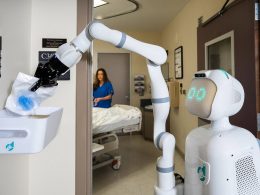The Internet of Things (IoT) has rapidly emerged as a revolutionary technology that is transforming how we interact with the world. At its core, IoT refers to a network of interconnected physical objects that use sensors and software to communicate with each other over the internet. These devices can collect, share, and analyze data, and even control one another remotely, enabling a vast array of automation possibilities in both personal and business settings.
Understanding the Basics of IoT

The fundamental principle of IoT is interconnectivity. Devices ranging from thermostats and refrigerators to industrial machines and vehicles are connected to the internet, allowing them to communicate with each other and with users. This interconnectivity enhances convenience, efficiency, and control.
For example, with an IoT-enabled thermostat, you can check and adjust the temperature of your home remotely via your smartphone, even if you are miles away. This type of remote control is just one small facet of what IoT can achieve. Interconnected devices can share data and perform tasks without direct human intervention, streamlining everything from daily chores to complex business operations.
How IoT Works
IoT relies on several key components:
- Sensors and Devices: These capture data from their environment. For instance, sensors in a smart home system may detect temperature, light levels, or movement.
- Connectivity: Devices need a means to communicate, and IoT typically uses the internet as the backbone of this communication. Wi-Fi, Bluetooth, and other wireless technologies help these devices stay connected.
- Data Processing: Once data is collected, it needs to be processed. In some cases, this happens on the device itself; in other cases, data is sent to a cloud server where it is analyzed.
- User Interface: The user interface allows users to interact with IoT devices, often via mobile apps or web platforms. This is where you can control devices, view data, and monitor activities.
These components work in harmony to provide a seamless and automated experience for users, both in personal and industrial settings.
Benefits of IoT

The widespread adoption of IoT brings numerous benefits across various sectors. Here are some of the most significant advantages:
1. Enhanced Efficiency and Productivity
In industries, IoT helps companies automate repetitive tasks, monitor equipment in real-time, and reduce downtime. For example, factories can use IoT-enabled machinery to predict when equipment might fail and schedule maintenance before it becomes a critical issue. This not only prevents costly breakdowns but also improves the overall efficiency of operations.
2. Improved Decision-Making
IoT devices collect and analyze vast amounts of data, providing valuable insights into business processes. This data-driven decision-making can improve everything from supply chain management to customer service. Companies can optimize inventory levels, improve energy efficiency, and better understand customer behavior through IoT analytics.
3. Remote Monitoring and Control
IoT allows users to monitor and control devices from anywhere, at any time. In the healthcare sector, for instance, IoT-enabled devices can track patients’ vital signs remotely, providing doctors with real-time data without requiring the patient to visit the clinic. In homes, users can control appliances, lighting, and security systems remotely, enhancing convenience and security.
4. Cost Savings
By improving efficiency and reducing waste, IoT can lead to significant cost savings for businesses and consumers. Automated processes can help minimize energy consumption, reduce labor costs, and cut down on unnecessary repairs. Smart homes, for example, can optimize energy use by automatically adjusting lighting and heating based on occupancy, resulting in lower utility bills.
5. Enhanced Customer Experience
In retail, IoT can create personalized shopping experiences by analyzing customer preferences and behavior. For example, smart shelves can track product inventory in real-time and notify staff when stock is running low. Additionally, wearable devices can help customers navigate stores more easily or suggest products based on their preferences.
Real-World Examples of IoT
To better understand the potential of IoT, let’s look at a few practical examples:
1. Smart Homes

Smart homes are perhaps the most well-known application of IoT. Devices like smart thermostats, lights, security cameras, and voice assistants (e.g., Amazon Alexa or Google Home) communicate with each other to create an integrated home automation system. With voice commands or through a mobile app, users can control nearly every aspect of their home environment—from adjusting the temperature to locking doors—whether they’re at home or not.
2. Connected Vehicles
IoT is transforming the automotive industry with the development of connected cars. These vehicles can communicate with each other and with external systems to provide a safer, more efficient driving experience. For example, IoT-enabled cars can receive traffic updates, avoid accidents, and even detect when a component needs maintenance. Autonomous driving technology also heavily relies on IoT.
3. Industrial IoT
In industrial settings, IoT plays a crucial role in optimizing operations. Manufacturing plants, for instance, use IoT-enabled sensors to monitor machinery performance in real-time. This allows for predictive maintenance, reducing downtime and avoiding unexpected equipment failures. The ability to monitor energy consumption, track supply chains, and automate production processes also improves overall operational efficiency.
1. Case Study: General Electric (GE) and Industrial IoT

General Electric (GE) is a pioneer in the industrial IoT space. GE has implemented IoT in its machinery, such as jet engines and wind turbines, to track performance and predict when maintenance is required. Using sensors embedded in these machines, GE collects data that helps technicians identify issues before they lead to breakdowns, reducing downtime and repair costs. GE estimates that its IoT solutions have saved millions of dollars by avoiding unplanned outages and improving operational efficiency.
2. Case Study: Amazon and Smart Warehouses
Amazon has integrated IoT into its warehouse operations to create highly efficient, automated fulfillment centers. IoT devices like sensors, robotics, and RFID (radio-frequency identification) tags work together to streamline the inventory management process. These devices track items throughout the warehouse, ensure proper stock levels, and help guide robotic systems that pick and pack orders. By leveraging IoT, Amazon can process and ship orders more quickly, minimizing human error and reducing labor costs.
3. Case Study: John Deere and Precision Agriculture
John Deere, a leading agricultural equipment manufacturer, uses IoT in its precision farming technology. By equipping tractors and other equipment with IoT-enabled sensors, John Deere provides farmers with real-time data on soil conditions, crop health, and weather patterns. This allows farmers to make informed decisions about when and where to plant, irrigate, and harvest crops, improving yields and reducing resource waste. As a result, farmers can maximize their productivity and profitability while minimizing environmental impact.
The Future of IoT
As IoT technology continues to evolve, its applications will become even more widespread. One area of particular growth is the Industrial Internet of Things (IIoT), which will see an increasing number of industries adopting IoT to optimize their operations. Smart cities, where IoT sensors monitor traffic, energy usage, and public safety, are another emerging trend that promises to enhance urban living.
In the healthcare sector, IoT will continue to revolutionize patient care with more advanced wearable devices and remote monitoring systems. Smart devices will not only track vital signs but also integrate with AI to predict potential health issues before they arise, allowing for proactive treatment.
Conclusion
The Internet of Things is changing the way we live and work, offering unprecedented convenience, efficiency, and insight. From smart homes to industrial automation, IoT is making it possible to monitor, control, and optimize nearly every aspect of daily life and business operations. With real-world applications in industries like manufacturing, agriculture, and healthcare, IoT is more than just a buzzword—it’s a transformative force that is reshaping our future.










